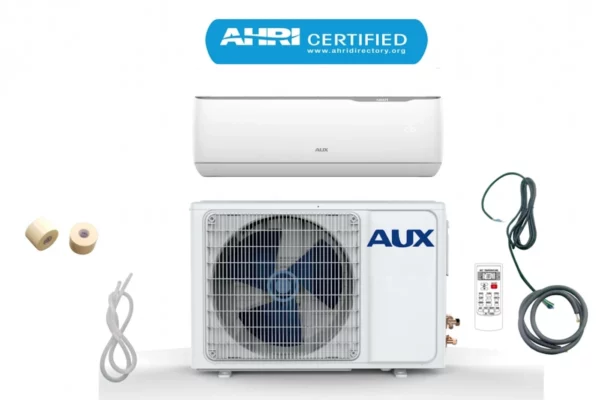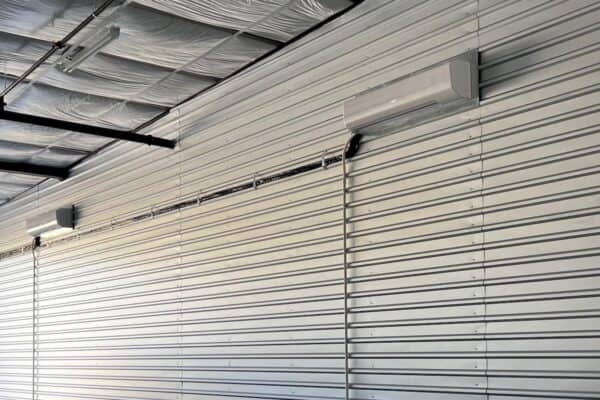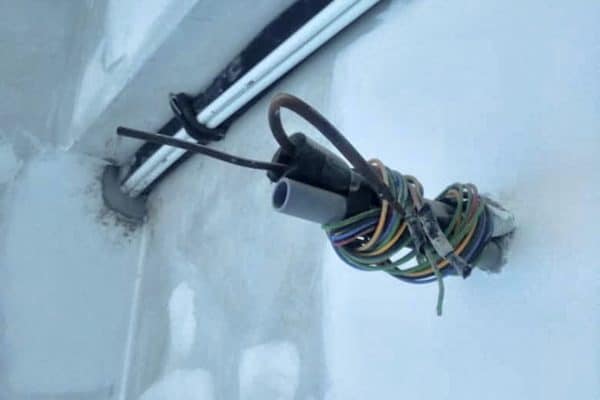Mini Split vs VRF: What’s the Difference?
Mini splits and VRF systems have many similarities. In certain applications, both are viable. However, many people are not familiar with mini splits, let alone VRF systems. So, what’s the difference between a mini split and a VRF?
The outdoor unit of mini splits requires a pair of refrigerant pipes for each of its corresponding indoor units. On the other hand, the outdoor unit of VRF systems only has a pair of refrigerant pipes regardless of how many indoor units it is connected to.
Hence, when there are multiple indoor units, VRF systems don’t need several pairs of refrigerant pipes like the single-zone and multi-zone mini splits do.
What Type of System is Mini Splits?
Mini splits are a direct expansion type of air conditioning system. A direct expansion system sends the refrigerant directly to the indoor unit for cooling or heating.
Contrarily, an indirect expansion air conditioning system sends another coolant like water to the indoor unit for cooling and heating. For instance, the chilled water system.
On the other hand, VRF systems are also a direct expansion system. Although they only have a pair of refrigerant pipes, all indoor units are still directly using refrigerant for cooling and heating.
Are Mini Splits VRF Systems?
Mini splits have several types of indoor units including wall-mounted, ceiling cassette, floor-mounted and even ducted units. Meanwhile, the same type of indoor unit can also be found in VRF systems.
So, are mini splits VRF systems?
Apparently, VRF is a technology. It stands for variable refrigerant flow. As the name suggests, it is an intelligent refrigerant management system that distributes the required amount of refrigerant to each of the associated indoor units based on the cooling/heating demand.
In comparison, multi-zone mini splits don’t distribute refrigerant like the VRF does. They work just like single-zone mini splits but instead of multiple small outdoor units, multi-zone mini splits use one large outdoor unit.
That’s why several pairs of refrigerant pipes are connected to one multi-zone outdoor unit. Each pair of refrigerant pipes is corresponding to each of the connected indoor units.
Therefore, mini splits are not considered VRF systems.
In fact, manufacturers separate mini splits from VRF systems in their brochures, website and other forms of communications. This further implies that mini splits are not VRF.
By the way, if you want to learn more about mini split especially how to design it for your house, consider my Mini Split (eBook). You’ll learn what is Mini Split, how to choose and more importantly, spark more design ideas to improve the energy efficient of your house. But, if you need a second opinion or want someone to help you design, then you can consider my consultation service.
Consultation Service
Ask me for HVAC advice such as brand selection, best model, benefits, features, placement, duct size, grille size, how to design, design check, verification and other HVAC related queries.
What is the Difference Between Mini Splits and VRF?
As mentioned earlier, both mini splits and VRF systems have the same type of indoor unit. However, the indoor unit meant for mini splits can’t be used in VRF systems because a special control board is needed.
VRF systems use dedicated VRF indoor units and VRF outdoor units.
Also, VRF systems only have a pair of refrigerant pipes while multi-zone mini splits have several pairs depending on the number of indoor units.
Apart from that, let’s compare other differences between mini splits and VRF systems:
Single-Zone Mini Split vs VRF
A single-zone mini split is very different from a VRF system. A single-zone mini split is usually capped at around 24,000 BTU of cooling capacity.
Meanwhile, some of the smallest VRF systems start at around 18,000 BTU and they can up to 54,000 BTU and even 300,000 BTU or more. VRF systems can be scaled up by means of adding more modules which is the outdoor unit.
Some of the largest VRF systems that I’ve seen are around 552,000 BTU and that’s a whopping 46 tons in a single air conditioning system. Of course, they are only used in large commercial buildings.
Since VRF systems are generally large in cooling/heating capacity, their outdoor units are also physically larger than single-zone mini splits with many of them starting with two fans, much like a multi-zone mini split outdoor unit.
In the event of a refrigerant leak, VRF systems are very costly to repair since the refrigerant in the entire line will be gone. Whereas for single-zone mini splits, it is on a case-by-case basis.
Multi-Zone Mini Split vs VRF
Compared to single-zone mini splits, multi-zone mini splits are much more similar to VRF systems since they both have one outdoor unit connected to multiple indoor units.
However, the biggest difference between a multi-zone mini split and a VRF system is the number of refrigerant pipes.
For example, a 5-zone mini split outdoor unit will have 5 pairs of refrigerant pipes with each pair connected to one indoor unit. Whenever a zone needs cooling/heating, the multi-zone outdoor unit will activate the corresponding indoor unit.
In a sense, it works just like a single-zone mini split.
Whereas VRF systems use special copper fittings called the y-joint or Refnet to branch out the refrigerant pipe. Two pairs of refrigerant pipes are connected to one y-joint and become one pair of refrigerant pipes again.
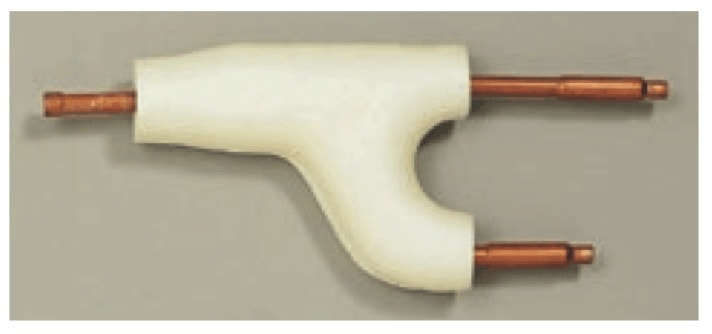

Whenever a pair of refrigerant pipes passes through a VRF indoor unit, a y-joint is used to connect the new pair of refrigerant pipes and the previous pair of refrigerant pipes. As a result, the number of refrigerant pipes remained at one pair at the VRF outdoor unit.
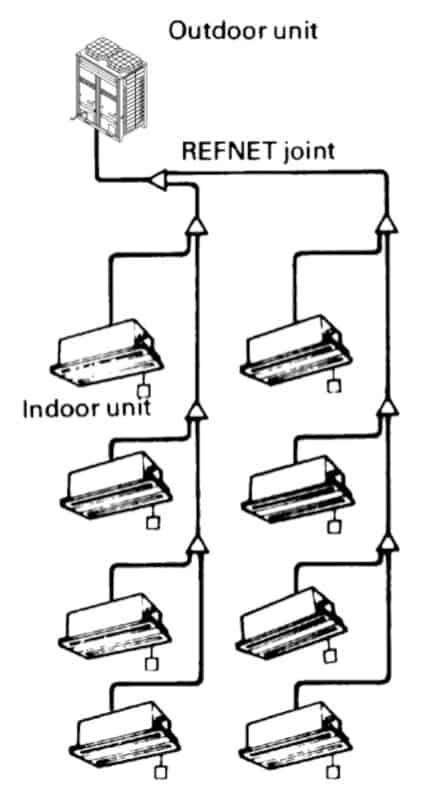
Some VRF systems use refrigerant distribution branch boxes instead of y-joints. These VRF systems are usually entry-level models. Large VRF systems always use y-joints.
So, compared to multi-zone mini splits, VRF systems are even neater and space-saving. However, similar to VRF systems, a refrigerant leak in multi-zone mini splits is equally costly.
Copper Pipes
Compared to mini splits (single-zone or multi-zone), the copper pipe required for VRF systems is slightly thicker because VRF systems operate at a slightly higher pressure.
Furthermore, most mini splits allow only the refrigerant gas line to be insulated while leaving the refrigerant liquid line uninsulated. However, for VRF systems, both refrigerant pipes must be insulated as both lines are cold enough to incur condensation.
Operation
Some VRF systems don’t allow you to turn the main power to the VRF outdoor unit off even when you’re not around for quite a while because it may disturb their settings. However, newer VRF systems don’t have this concern.
Is VRF a Central Air Conditioning System?
Traditionally, a central air conditioning system is a home air conditioning system that doesn’t allow temperature zoning. Often, the entire house temperature is controlled by one thermostat.
On the other hand, VRF systems are a type of centralized air conditioning system. However, unlike conventional central air systems (furnace + split condenser), VRF systems allow temperature zoning and each indoor unit can be controlled independently.
Most of the time, VRF systems have a dedicated centralized monitoring and control system. For simple applications, it is in the form of a wired display controller. However, the wired display controller doesn’t have a built-in thermostat. Rather, it is just for monitoring and controlling purposes.
The wired display controller used for VRF systems is not used for temperature sensing. Instead, each VRF indoor unit has its own built-in temperature sensor. Information such as each indoor unit’s room temperature, settings and schedules can be seen and controlled by the wired display controller, making it a centralized controller.
In comparison, conventional central air systems use a wired thermostat for temperature controls. The thermostat is a temperature sensor by itself and the entire house temperature is depending on the thermostat.
Since VRF systems don’t depend on a single temperature sensor and setting, they are not considered central air conditioning systems.
However, in terms of operation, VRF systems can be monitored and controlled in one place.
In commercial applications, VRF systems can be connected to the building management system (BMS) where operators can monitor and control all mechanical and electrical services including the VRF air conditioning system.
VRF systems are much more advanced and complex than mini splits.
Consequently, VRF systems are much more expensive than mini splits and they are often not practical for residential applications. However, smaller VRF systems like the Daikin VRV LIFE or the Mitsubishi S-Series VRF are feasible for cooling and heating a whole single-family house.
If you’re interested to learn more about VRF in detail, see my post VRF Working Principle (Air-cooled & Water-cooled).
To see examples of the VRF system design in homes, check out the below posts:
Conclusion
Mini splits are not VRF systems. VRF is a technology and mini splits that we know don’t possess the characteristics of VRF systems. Meanwhile, VRF is also not a central air conditioning system. Instead, VRF systems are air conditioning systems of their own.
In summary, the differences between a mini split and a VRF are as follow:
- Multi-zone mini splits have multiple pairs of refrigerant pipes while VRF only needs one pair.
- VRF capacity is significantly larger than mini splits and hence, more suitable for large applications.
- Refrigerant leakages are very costly to repair in VRF and multi-zone mini splits but not single-zone mini splits.
- VRF systems are significantly more expensive than mini splits.
- Mini splits often allow one of the refrigerant pipes to be uninsulated but VRF systems require both refrigerant pipes to be insulated.
- The copper pipe thickness for VRF systems is greater than mini splits.
- Mini splits and VRF systems use the same type of indoor unit but they are not interchangeable because VRF indoor units required a special control board.
- VRF systems have sophisticated communication systems while the control for mini splits is much simpler.
Despite having many differences, mini splits and VRF systems have many similarities too. For instance, both of them are direct expansion air conditioning systems. Besides, they are air-cooled, meaning they rely on ambient air for heat transfer. Furthermore, their compressors are variable speed. Moreover, multi-zone mini splits and VRF systems both have only one outdoor unit which is space-saving.
Nonetheless, if you need something efficient and compact, a VRF system is worth considering. Just keep in mind that you’ll need a higher budget.
Lastly, consider my Mini Split (eBook) if you want to know how can you use Mini Split in your house. If you still have doubt or not feeling confident enough, feel free to consult me.
Consultation Service
Ask me for HVAC advice such as brand selection, best model, benefits, features, placement, duct size, grille size, how to design, design check, verification and other HVAC related queries.
If you have anything to add (or ask) about this topic, leave a comment down below!




